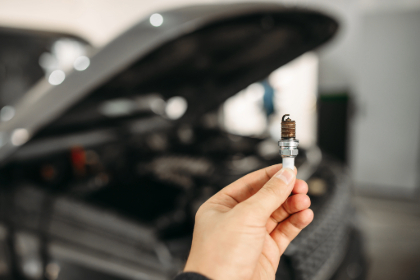INDEPENDENT DEALER
Sanford, NC | (800) 781-8840 ext 1
OUR BLOG
Improve car ignition with a quick spark plug replacement. This guide from Tarheel Synthetics in Sanford, NC, shows you how!

Spark plugs may be tiny, but they play a huge role in your car’s performance. They spark the fuel-air mix, making for smooth starts. The problem arises when they wear out and aren’t replaced. You might experience misfires, rough idling, or poor gas mileage. That’s why it's crucial to change them regularly.
In this post, we’ll guide you through a simple, step-by-step spark plug replacement process. Read on to learn more!
Keep your engine performing at its best with premium AMSOIL synthetic oils! Call Tarheel Synthetics in Sanford, NC, at (800) 781-8840 ext 1 for expert advice on the right formula for your car. Also, remember you can head to AMSOIL's store and restock your car care essentials anytime.
Tools & Materials Needed for Replacement
Before you get started, gather these essential tools and materials:
Basic Tools:
- Ratchet and spark plug socket (with rubber insert)
- Socket extension bar
- Torque wrench
- Spark plug gap gauge
- Anti-seize compound (optional)
- Dielectric grease (optional)
- Compressed air or a small vacuum
Safety Gear:
- Gloves
- Safety glasses
Having everything ready will make the job smoother and safer.
Preparing to Work on Your Engine
Before getting started, ensure the engine is cool to avoid hazards. Likewise, disconnect the negative battery terminal to prevent shocks and reset systems. Clean the area around the spark plugs using compressed air or a vacuum to prevent dirt or debris from falling into the cylinders. You may also need to remove plastic engine covers or hoses that block access.
Spark Plug Replacement, Step by Step
Step 1: Locate the Spark Plugs
Spark plugs are usually easy to spot once you know where to look. You’ll often find them along the engine's top or side, in straight-row underwires or coil packs. Check your repair manual or search online for exact locations.
Step 2: Remove the Ignition Coils or Spark Plug Wires
Carefully detach the spark plug wires by gripping the boot, not the wire itself, to avoid damage. If your car uses ignition coils, remove the bolts holding them in place and gently pull them out.
Label the wires or coils as you go to avoid mixing up the order during reinstallation.
Step 3: Blow Out or Vacuum Debris
This step is crucial. Use compressed air or a vacuum to remove dirt or debris around the spark plug holes. If you skip this step, grime could fall into the cylinder and cause internal engine damage.
Step 4: Remove the Old Spark Plugs
Insert your spark plug socket and slowly unscrew the plug counterclockwise. Work gently, as forcing it can damage the threads or break the plug.
Remove and replace one plug at a time to avoid confusion.
Don't settle for average engine protection. AMSOIL's Signature Series 0W-20 Synthetic Motor Oil delivers unbeatable performance and lasting power. Call Tarheel Synthetics in Sanford, NC, now at (800) 781-8840 ext 1, or visit AMSOIL online to refill your car care essentials today.
Step 5: Inspect the Old Plugs
Take a close look at the spark plug you removed:
- Light tan or gray deposits \= Normal wear
- Oily or black deposits \= Possible oil leaks or rich fuel mixture
- White or cracked ceramic \= Overheating or detonation issues
If you see anything unusual, snap a photo or save the plug to discuss with a mechanic later.
Step 6: Check and Adjust the Gap on New Spark Plugs
Even if your new spark plugs are pre-gapped, it’s wise to double-check.
Use a spark plug gap gauge to measure the gap between the center and ground electrode. If it’s not within your manufacturer’s specs, gently adjust it.
A proper gap ensures a strong, consistent spark for the best performance.
Step 7: Install the New Spark Plugs
Optional: Lightly coat the threads with an anti-seize compound, but only if your car’s manufacturer recommends it.
Thread the plug into the cylinder by hand first to avoid cross-threading. Then, tighten it using a torque wrench to the spec in your owner’s manual.
Avoid overtightening, as this could crack the plug or damage the engine threads.
Step 8: Reinstall Ignition Coils or Spark Plug Wires
Optional: Apply a dab of dielectric grease inside each spark plug boot to improve the seal and prevent moisture issues.
Reinstall the ignition coils or spark plug wires in the correct order. Make sure they’re firmly connected.
Step 9: Reassemble and Test
Put back any engine covers or parts you removed. Reconnect the battery and start the engine.
Listen for a smooth idle and responsive acceleration. If everything sounds and feels good, take your car for a short test drive to confirm the performance boost.
Conclusion
Replacing spark plugs is a simple but significant DIY task that enhances power, efficiency, and engine lifespan. Stick to your manufacturer’s maintenance schedule, and your car will thank you with smoother starts and better mileage.